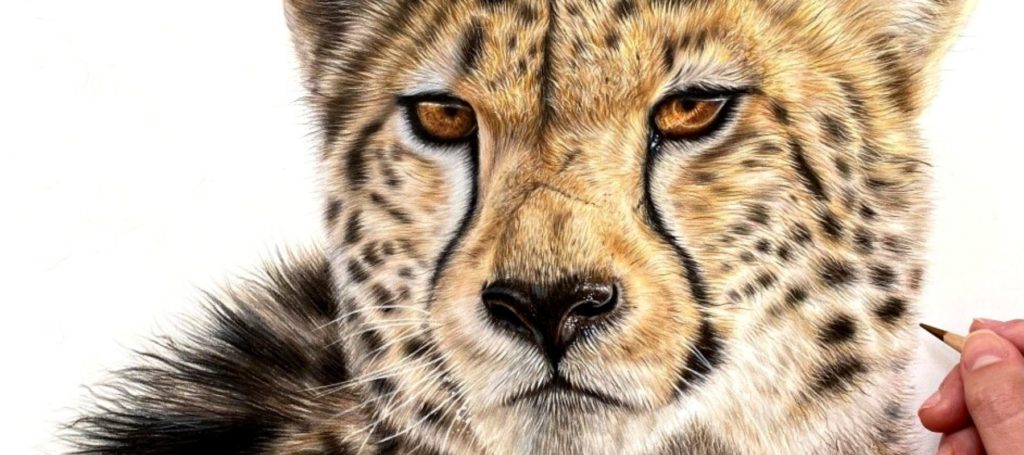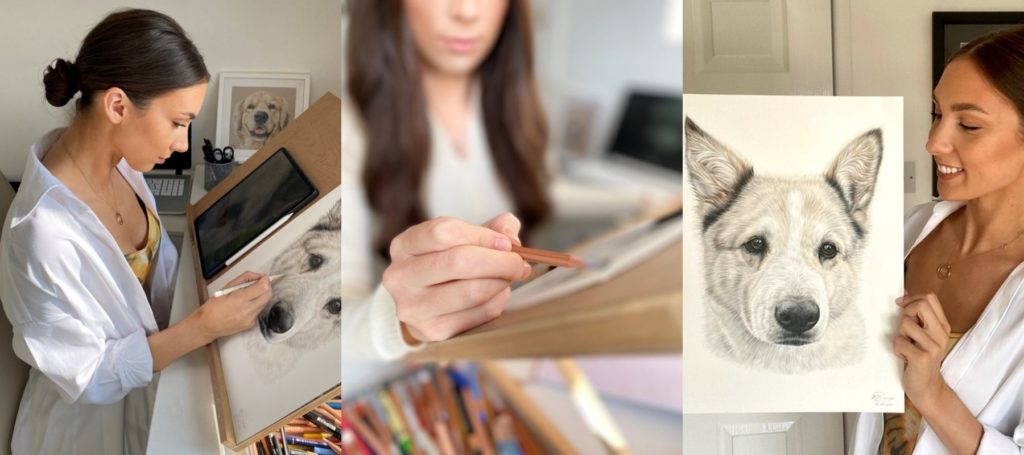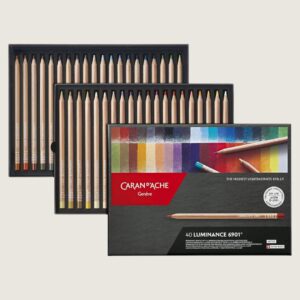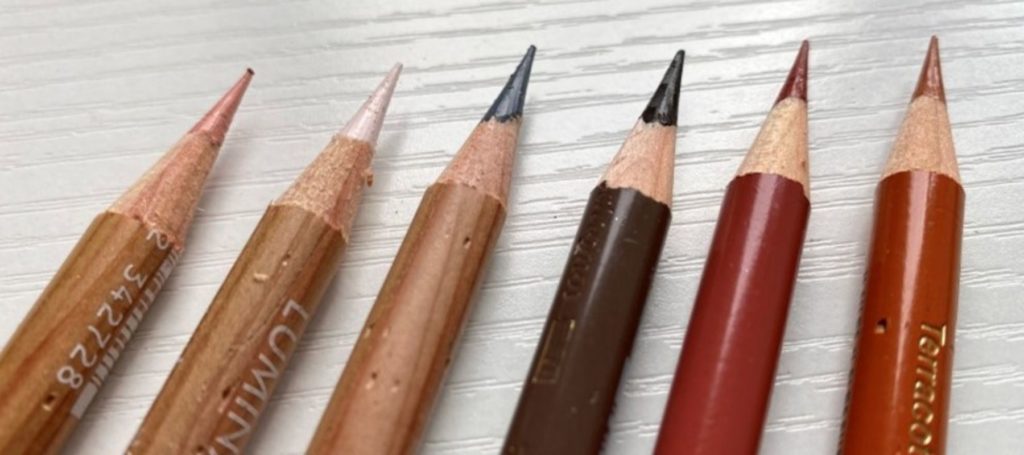How to use Faber Castell Polychromos and Caran D’Ache Luminance coloured pencils
Becca Barron | 23rd January 2023

I’m Becca, a professional Pet Portrait and Wildlife Artist based in Preston, Lancashire. I choose to create my authentic portraits in coloured pencils, as they allow for accuracy and depth through an incredible control of detail. I enjoy the timely process of building up layers, to recreate fur textures, through every delicately placed pencil stroke. Bringing the subject to life on the paper, through intricate professional techniques and patience, is why my artwork is so well respected, due to the precision and the time I put into each and every hand drawn original piece.

I use a mixture of Faber Castell Polychromos and Caran D’Ache Luminance coloured pencils, both of which complement each other really well. Polychromos are predominantly oil based, so they are a much harder pencil and are perfect for achieving intricate details with that pin point sharp point. I find that the colours are more vibrant compared to the luminance pencils. The luminance pencils, I love to use as base layers and to blend pigments together. They are predominantly wax based, so a much softer pencil than the polychromos, meaning they provide that really creamy base to work on top of and they can smudge pigments together really easily. There are many neutral shades in the luminance pencil range, which are perfect for all fur types. Especially when drawing white fur on white paper, those neutral paler tones create a subtle smooth finish.
5 Tips for using Faber Castell Polychromos and Caran D’Ache Luminance Pencils:
1. Base Layers
When drawing realistic animals with coloured pencils, you want to start by building up the tonal values, before worrying too much about the details. To start this process, I go in with a light to medium pressure using pale coloured luminance pencils, such as, ‘Buff Titanium’, ‘Pink White’ and ‘Silver Grey’. Each of these are really pale, but have a subtle tint to them. Having these as the first few base layers provides that really creamy base to layer on top of. I find the pigments start blending together much easier.
2. Undertones
I then like to go in with a polychromo pencil, using a more vibrant colour with a light pressure, to add that subtle undertone to the fur. For example, if I was drawing ginger coloured fur, I’d perhaps add a light layer of ‘Ivory’ or ‘Cream’, over those base layers, to create that yellowy golden undertone.
3. Tonal Values
Building up tonal values is the main body of the work. Especially with coloured pencils, it’s a very timely process that requires a lot of patience to be able to build up colour and tone in a way that creates depth to the subject, and captures the lighting bouncing off the fur. To capture the lighting, I like to use vibrant, bright colours in and amongst layers, with a light pressure to keep it subtle. Sometimes a strong light source will pull a whole array of colours from the fur. I’d use polychromos for this, due to the extensive range of rich colours. You want to ensure you have a clear contrast too, between your darkest and lightest areas. The luminance pencils, I use to blend pigments together and reduce that grainy texture from the tooth of the paper. I use hot pressed Fabriano Artistico paper, which has a fine tooth, enabling it to hold a lot of layers.[/vc_column_text][vc_column_text]
4. Details
I try and build up an element of detail from the beginning of my work by simply drawing in the same direction as the fur, and being able to see some of those individual pencil strokes, which represent the hairs in the fur. Once the tonal value has been built up, I can focus on those finer, intricate lines. I use polychromos to add in the details, and soften those lines if I need to with the luminance pencils.
5. Refinements
In addition to the coloured pencils, I like to use the ‘Craft Knife Slice Tool’ and the ‘White Fine Nib Uniball Posca Pen’, to elevate the realistic element in my work. The craft knife slice tool works by removing those top layers of coloured pencil, revealing the paper underneath, meaning you can pull out highlights in the fur, draw in whiskers and add really fine lines that you wouldn’t necessarily be able to achieve just by using coloured pencils alone. The white uniball posca pen is perfect for those bright white highlights in the eyes.
Step-By-Step guide tutorial for using Faber Castell Polychromos and Caran D’Ache Luminance coloured pencils
This is also available as a full in-depth tutorial, for free, on my YouTube Channel
Step 1
Start with your base layers, mapping out the shapes. ‘Buff Titanium’ luminance pencil and a warm grey l, would be the perfect colours for these initial stages.
Map out the basic shapes in the eye, with a sharp dark sepia and gradually build up the dark shadows.
Merge the light and dark areas of the fur at the edges so those hairs look soft and it’s obvious which direction they’re going in.
For the iris, add some rich orange undertones, make the eye look spherical by darkening the outer edges. Use the white uniball posca pen to dot in those intricate highlights in the eye, which show the reflections of the light.

Step 2
Start building up more of the surrounding fur, using more beige tones, like the ‘Raw Umber 10%’ luminance pencil, ‘Bistre’ polychromo and ‘Nougat’ polychromo.
Darken those deep wrinkles in the face, using the dark sepia with a really hard pressure to squash down the tooth of the paper, to avoid that grainy texture.
Map out the shapes in the ear and build up the tonal value through multiple layers.
Use the craft knife slice tool to flick up at the top of the head on the left, where that fur meets the base of the ear. This will create depth, showing how areas are in front and behind each other.sd

Step 3
Repeat the same process for the top right hand side of the French bulldogs face.
Keep building up those shadows by applying a hard pressure in those darkest areas. This will help to build up the contrast and help to capture the light.
Keep building up the hair details by using a sharp polychromo pencil, and smooth out the lines with a neutral luminance pencil if you need to

Step 4
Build up the snout, nose and mouth area, using a range of warm greys (polychromos).
For the base layers of the snout, I’d recommend using the ‘French Grey 30%’ and the ‘Sepia 10%’ to help build those darker pigments together and add a subtle tint of brown and purple.
For the mouth area, use the shade ‘Carput Mortuum’ which is a maroon colour, to add an element of dark red.
Use the craft knife slice tool to add subtle fine whiskers.

Step 5
Refine everything; add those finishing touches. Tweak and alter areas of the drawing until it has that element of realism.
Remember, you never want a photo replica; you want your work to be original. Having more of a representation of the reference photo, focusing on capturing the subject’s character, will be far more authentic.
Use the craft knife slice tool to pull out any final highlights in the fur.

Author Becca Barron
I’m Becca, a professional Pet Portrait and Wildlife Artist based in Preston, Lancashire. My pet portraits are created on a commission basis for clients all over the world. I bring my love for animals and art together by creating the highest quality realistic coloured pencil drawings of animals, capturing the characters and beauty of your pets.
In my original wildlife portraiture, I like to work from carefully selected photographs, which often capture a close-up, personal moment of the subject in a strong light. This enables me to achieve an exceptional amount of detail in each of my pieces, drawing attention to the beauty and expression of each animal depicted, often portraying an intimate emotional encounter.
After studying art for many years and holding a Fine Art degree, I now share my knowledge and passion with others through online teaching platforms, like Patreon and YouTube, offering a range of tutorials and creative business guidance.



